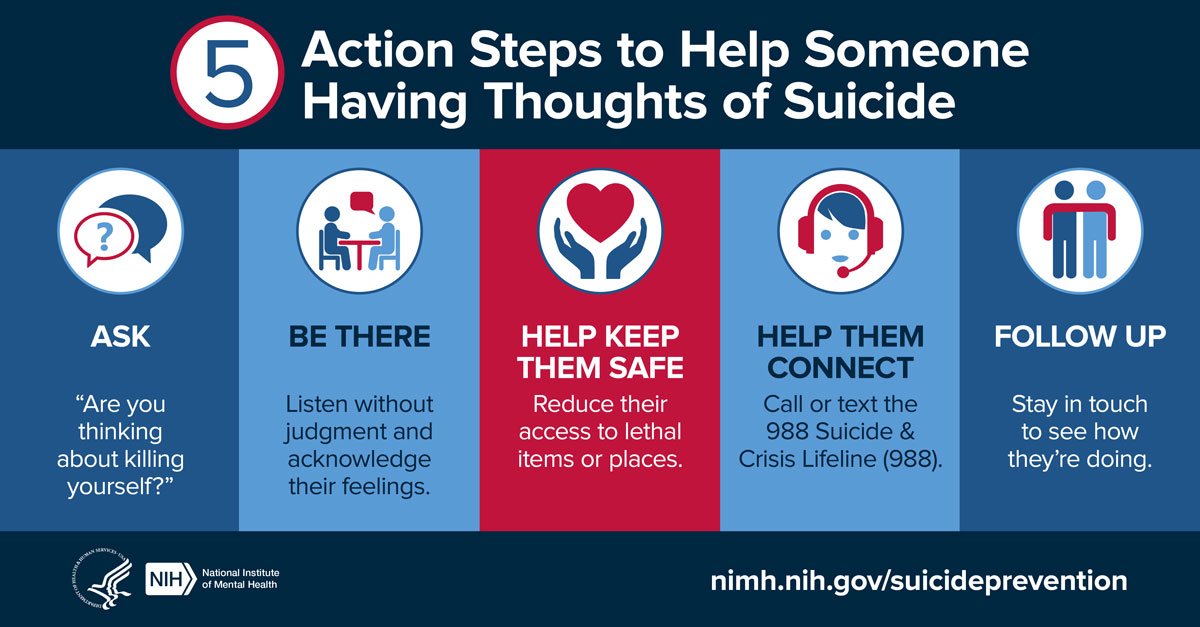Trauma and Injury Prevention
Suicide Prevention
Dallas County Health and Human Services - 2377 N. Stemmons Freeway, Dallas, TX 75207
Telephone: 214-819-2000
In Crisis? Get Help Now:


Suicide is not inevitable for anyone. By starting the conversation, providing support, and directing help to those who need it, we can prevent suicides and save lives.
 |  |  |
- Suicide is when people harm themselves with the intent of ending their life, and they die as a result.
- A suicide attempt is when people harm themselves with the intent of ending their life, but they do not die.
**Avoid using terms such as “committing suicide,” “successful suicide,” or “failed suicide” when referring to suicide and suicide attempts, as these terms often carry negative meanings.**
Warning signs that someone may be at immediate risk for attempting suicide include:
- Talking about wanting to die or wanting to kill themselves
- Talking about feeling empty or hopeless or having no reason to live
- Talking about feeling trapped or feeling that there are no solutions
- Feeling unbearable emotional or physical pain
- Talking about being a burden to others
- Withdrawing from family and friends
- Giving away important possessions
- Saying goodbye to friends and family
- Putting affairs in order, such as making a will
- Taking great risks that could lead to death, such as driving extremely fast
- Talking or thinking about death often
Other serious warning signs that someone may be at risk for attempting suicide include:
- Displaying extreme mood swings, suddenly changing from very sad to very calm or happy
- Making a plan or looking for ways to kill themselves, such as searching for lethal methods online, stockpiling pills, or buying a gun
- Talking about feeling great guilt or shame
- Using alcohol or drugs more often
- Acting anxious or agitated
- Changing eating or sleeping habits
- Showing rage or talking about seeking revenge
People of all genders, ages, and ethnicities can be at risk.
The main risk factors for suicide are:
- Depression, other mental disorders, or substance use disorder
- Chronic pain
- Personal history of suicide attempts
- Family history of a mental disorder or substance use
- Family history of suicide
- Exposure to family violence, including physical or sexual abuse
- Presence of guns or other firearms in the home
- Having recently been released from prison or jail

If you observe warning signs of suicide in someone you know, here are five steps you can take to help them:
- ASK: “Are you thinking about killing yourself?” It’s not an easy question but studies show that asking at-risk individuals if they are suicidal does not increase suicides or suicidal thoughts.
- KEEP THEM SAFE: Reducing a suicidal person’s access to highly lethal items or places is an important part of suicide prevention. While this is not always easy, asking if the at-risk person has a plan and removing or disabling the lethal means can make a difference.
- BE THERE: Listen carefully and learn what the individual is thinking and feeling. Research suggests acknowledging and talking about suicide may in fact reduce rather than increase suicidal thoughts.
- HELP THEM CONNECT: Save the 988 Suicide & Crisis Lifeline number (call or text 988) and the Crisis Text Line number (741741) in your phone so they’re there if you need them. You can also help make a connection with a trusted individual like a family member, friend, spiritual advisor, or mental health professional.
- STAY CONNECTED: Staying in touch after a crisis or after being discharged from care can make a difference. Studies have shown the number of suicide deaths goes down when someone follows up with the at-risk person.
FIND HELP near you:
- Click here to link you to our website.
- Put in your zip code.
- Navigate to the top bar to find resources for: mental health, housing, food, support, transportation, work, financial assistance, and legal.
- You can set personal filters, program filters, and income eligibility.
If you are a minor or young adult (ages 10-24), find resources here:
If you are looking for LGBTQ+ specific resources, find them here:
If you are a veteran, find resources here:
Para recursos en español, haz clic aquí:
If you would like to learn more about suicide prevention:
QUICK LINKS
LOCATIONS
EMPLOYEES
-
You must be on the network to see these links.





